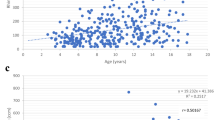Abstract
The aim of present study was to define a normal range of total nasal airflow resistance in the healthy population of Chattisgarh. This study was conducted at the Department of Otorhinolaryngology, Medical College Raipur, Chattisgarh over 93 healthy adults. A proper otolaryngology examination was done prior to the study and all the subjects were free from any type upper respiratory tract infection. This was the main inclusion criteria for the present study. All the subjects were distributed according to age and sex. Active Anterior Rhinomanometry is the best recommended method for evaluating the objective assessment of nasal airflow resistance; it was preferred for the assessment of total nasal airway resistance in present study also. The present study concluded that the mean value of total nasal airway resistance was 0.21 at 150 Pa pressure. However the range of total nasal airway resistance was from 0.142 to 0.34 Pa/cm3/s at the same pressure. The present study presents the normal range and mean value of total nasal airway resistance for the healthy adult population of Chattisgarh. Total nasal airway resistance is independent of age and sex.
Similar content being viewed by others
References
Kayser R (1895) Die exacte Messiung der Luftdurchgangikeit der Nase. Archiv fur Laryngologie and Rhinologie 3:101–120
Clement PAR (1984) Committee report on standardization of Rhinomanometry. Rhinology 22:151–155
Ohki M, Naito K, Cole P (1991) Dimensions and resistances of the human nose: racial differences. Laryngoscope 101:276–278
Suzina AH, Hamzah M, Samsudin AR (2003) Active anterior rhinomanometry analysis in normal adult Malays. J Laryngol Otol 117:605–608
Bermullar C, Kirsche H, Rettinger G, Riechelmann H (2008) Diagnostic accuracy of peak nasal inspiratory flow and rhinomanometry in functional rhinosurgery. Laryngoscope 118:605–610
Morris S, Jawad MS, Eccles R (1992) Relationships between vital capacity, height and nasal airway resistance in asymptomatic volunteers. Rhinology 30:259–264
Younis F, Duvvi S, Walker T, Kumar BN (2007) Sino-nasal assessment questionnaire: a specific outcome measure for rhinosinusitis, but what is the range in the asymptomatic population? J Otolaryngol 121:650–652
Author information
Authors and Affiliations
Corresponding author
Rights and permissions
About this article
Cite this article
Gupta, S., Bansal, A., Ramnani, S. et al. Assessment of Nasal Airflow Resistance in the Healthy Population of Chattisgarh by Active Anterior Rhinomanometry. Indian J Otolaryngol Head Neck Surg 64, 338–340 (2012). https://doi.org/10.1007/s12070-011-0300-0
Received:
Accepted:
Published:
Issue Date:
DOI: https://doi.org/10.1007/s12070-011-0300-0




